全文HTML
--> --> -->目前, 在产生紫外皮秒355 nm激光的过程中, 一般利用Nd:YVO4或Nd:YAG晶体产生1064 nm基频光, 之后通过其三倍频产生355 nm紫外光. 具体步骤为∶ 通过基频光的多级放大提高1064 nm种子光的功率, 之后再进行倍频产生532 nm二次谐波并控制转换效率为50%左右, 1064 nm基频光与532 nm倍频光的光子数比接近2∶1入射到和频晶体中, 最终和频产生355 nm紫外输出[17]. 在和频过程中, 1064和532 nm的光子数配比对355 nm的产生至关重要. 532 nm的输出功率决定了最终355 nm的输出功率, 与此同时, 1064 nm的功率决定了532 nm到355 nm的转换速率, 即最高转换效率对应的最佳晶体长度. 在传统方案中, 由于1064 和532 nm的输出功率相互制约以及对晶体长度和光束质量的要求, 不得不通过限制532 nm的转换效率, 从而使得1064 nm基频光与532 nm倍频光光子数配比接近2∶1, 以缩短和频晶体的长度, 减少吸收和走离的影响. 但是, 由于532 nm的转换效率被限制, 使355 nm的最大输出功率也被限制. 因此, 在传统的方案中, 1064和532 nm的功率矛盾直接影响了355 nm产生的效率和晶体选择.
本文针对紫外皮秒355 nm激光腔外和频的效率提升提出了一种新的方案. 首先使用LiB3O5 (LBO)晶体对1064 nm种子光进行倍频产生532 nm二次谐波, 然后将1064 nm基频光分离并进行放大, 再将产生的二次谐波532 nm激光与放大后的基频光1064 nm激光在LBO晶体中进行和频. 通过对和频LBO晶体中的三波耦合方程进行理论分析计算, 讨论了不同功率密度配比下LBO晶体中各波长功率密度变化情况和LBO晶体吸收效应对于和频过程的影响, 并通过数据模拟证明了和频过程最终转化效率与LBO和频晶体长度的关系. 模拟结果与尤晨华等[18]在和频过程中对于转换效率的公式分析结果得出相同的变化趋势, 且与Ueda等[19]在进行紫外皮秒355 nm和频时不同入射条件下的实验数据相一致,证明了对1064 nm基频光分离再放大从而进一步提高紫外355 nm激光转换效率方案的可行性. 利用该方案可以在倍频时提高532 nm倍频光转换效率, 同时保证之后的和频过程可以在较短晶体长度下实现355 nm紫外光的高效转换输出, 最终使得紫外皮秒355 nm激光相对于传统方案输出功率提高40%以上. 该方案在基于腔外和频技术实现紫外皮秒激光高效输出的装置中有实际的应用价值.
2.1.基于基频放大的紫外皮秒355 nm输出效率提高系统实验装置
腔外和频产生紫外皮秒355 nm激光的装置图如图1所示, 其中图1(a)为传统限制倍频效率的方案装置图, 图1(b)为基于基频放大的和频实验装置图. 基频光为高功率1064 nm皮秒种子光, 经过透镜组L1和L2调整光斑直径并进行光束准直. 利用LBO倍频晶体的I类相位匹配(θ = 90°, φ = 11.7°)进行倍频, 可产生532 nm二次谐波. 在传统方案中由于之后和频过程中的入射光子数配比的要求, 限制倍频光532 nm的转换效率至50%. 本文在倍频时提高了532 nm倍频光的输出功率, 使532 nm倍频光转换效率可以达到65%甚至更高[20]. 倍频后利用双色镜DM1将1064 nm基频光与532 nm倍频光分离, 外加808 nm泵浦激光由双色镜DM2输入, 通过Nd:YVO4晶体将1064 nm基频光进行放大,从而调整入射到和频LBO晶体中的光子数配比. 532 nm倍频光采用对称结构并通过改变双色镜DM1与反射镜M之间的距离实现1064 nm基频光和532 nm倍频光的时间同步. 之后, 再将放大后的1064 nm基频光和532 nm倍频光通过双色镜DM3合束并入射到和频晶体LBO中, 采取II类相位匹配(θ = 43.5°, φ = 90°)进行和频产生紫外355 nm激光. 最终, 通过分光镜DM4将三束激光分离从而得到紫外皮秒355 nm激光输出.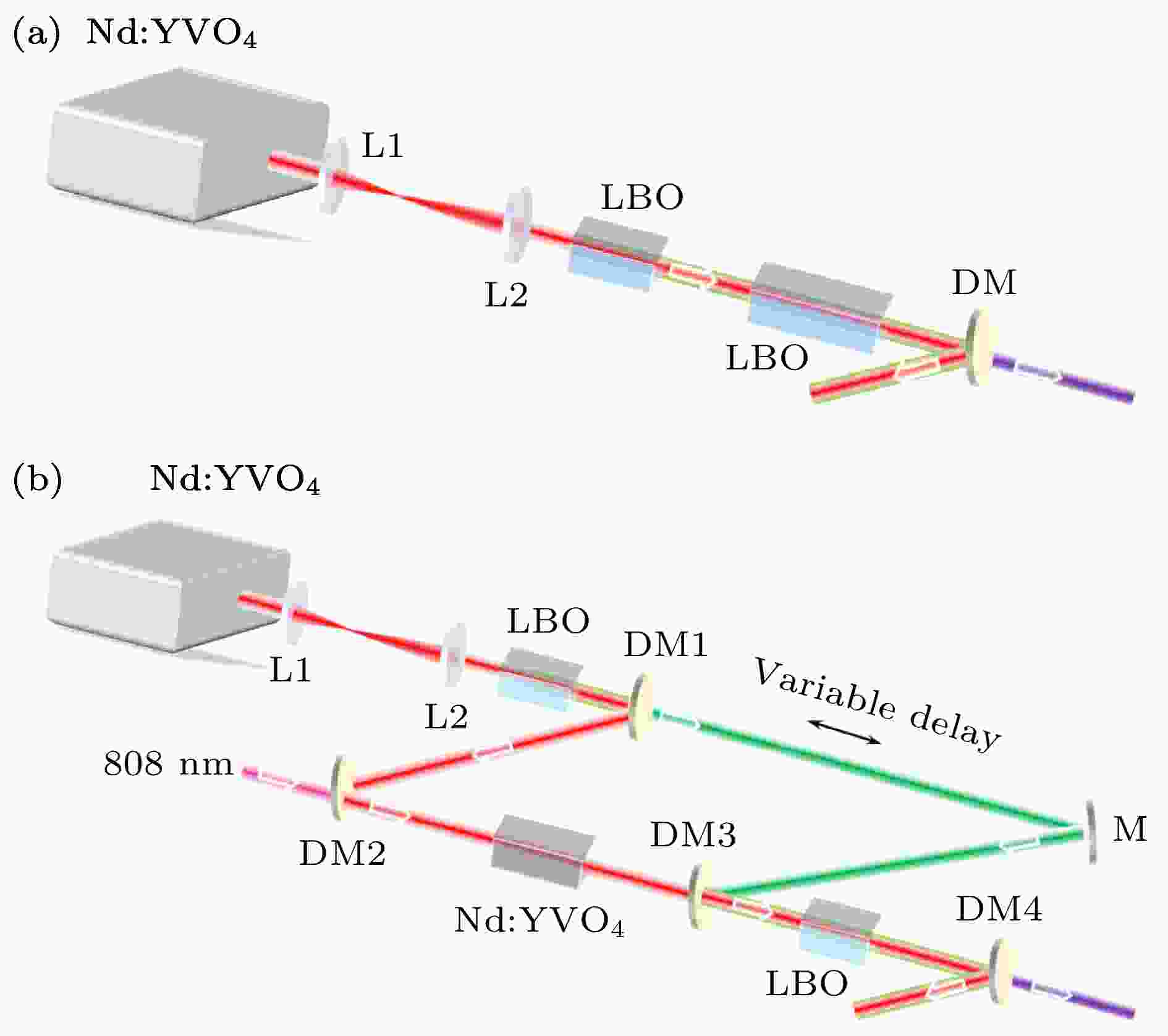 图 1 (a) 传统的355 nm产生装置图; (b) 基于基频放大的紫外皮秒355 nm输出效率提升系统装置图
图 1 (a) 传统的355 nm产生装置图; (b) 基于基频放大的紫外皮秒355 nm输出效率提升系统装置图Figure1. (a) Diagram of the traditional 355 nm generating device; (b) diagram of the UV picosecond 355 nm output efficiency improvement system based on fundamental frequency amplification
2
2.2.基于基频放大的紫外皮秒355 nm输出效率提高系统的理论分析
通过LBO和频晶体将1064 nm激光和532 nm激光进行和频从而得到紫外355 nm激光, 通常采用的是II类相位匹配, 由相位匹配条件和LBO晶体的折射率色散公式可以求得和频过程的相位匹配角度为θ = 43.5°, φ = 90°.在LBO和频晶体中, 1064 nm激光与532 nm激光和频产生355 nm激光的相互作用过程可利用三波耦合方程来进行分析研究. 设激光光束传播方向为Z轴, 则和频过程的三波耦合方程为[21,22]
对于1064 nm基频光和532 nm二次谐波和频产生355 nm三次谐波的相互作用过程, 1064 nm和532 nm激光功率密度相对可比且所求情况为高效率转换, 故不能按照小信号模型处理, 因此, 分别将三个光束对应条件代入三波耦合组中求解. 由能量守恒和动量守恒, 可知入射光束总能量和输出和频光束的总能量相等, 设总功率密度为P, 设



当R = ω1/(ω1+ω2), 即M = ω1∶ω2时, 入射光束功率密度之比等于其频率之比, 基频光和二次谐波光的光子数相同, 每产生一个355 nm和频光光子就消耗一个1064 nm基频光光子和一个532 nm倍频光光子, 进而椭圆函数转化为双曲线函数. 此时355 nm和频光要达到转换效率峰值所需要的晶体长度较长.
当R≠ω1/(ω1+ω2), 即M≠ω1∶ω2时, 输入光束光子不是严格按照频率配比, 则输出的355 nm和频光束功率密度将随着和频晶体的长度发生周期性的变化, 且1064 nm基频光光子数占比越高, 功率密度变化的周期越短. 通过改变入射光束的功率密度之比, 就可以有效地改变和频输出的最优晶体长度, 从而获得更高功率的紫外355 nm激光输出.
和频晶体对于不同频率的光束吸收效应不同, 用吸收系数αj (j = 1, 2, 3)表示晶体对于不同频率光束的吸收效应, 如(8)式所示, 在原三波耦合方程中加入晶体吸收项αjEj, 使原方程组的解由周期性转变为逐步衰减振荡. 同时, 和频过程中355 nm紫外光走离角度为17.9 mrad, 产生的355 nm紫外光会逐渐与入射光束分离, 影响最终输出的效率和光束质量. 要得到高效、高质量输出的紫外355 nm激光, 缩短晶体长度从而减少吸收和走离效应影响是一个重要的途径.
在理想条件下, 和频产生紫外355 nm皮秒激光的过程中, 每产生一个355 nm光子需要转换一个1064 nm光子和一个532 nm光子, 则入射到LBO和频晶体中的1064 nm基频光与532 nm倍频光功率密度之比M应为1∶2, 即光子数之比为1∶1, 532 nm倍频转换效率约为66.7%. 在LBO和频晶体中, 三个波长光束功率密度随晶体长度变化曲线如图2所示, 随着晶体长度的增长, 355 nm和频光束功率密度逐渐增加至逼近峰值, 此时1064 nm和532 nm入射光基本全部转化为355 nm和频光, 但达到峰值功率密度的晶体长度较长, 所需的晶体长度L为12.2 mm. 对于LBO和频晶体, 由于三个波长光束的折射率不同造成群速度色散失配和互相空间走离, 随着晶体长度的增长, 三个波长光束在时域和空间域上都逐渐分离, 造成和频效率的下降且影响光斑质量. 若要保持较高的光束质量和减少走离影响, 则需要减小和频LBO晶体的长度, 这限制了紫外355 nm输出的转换效率.
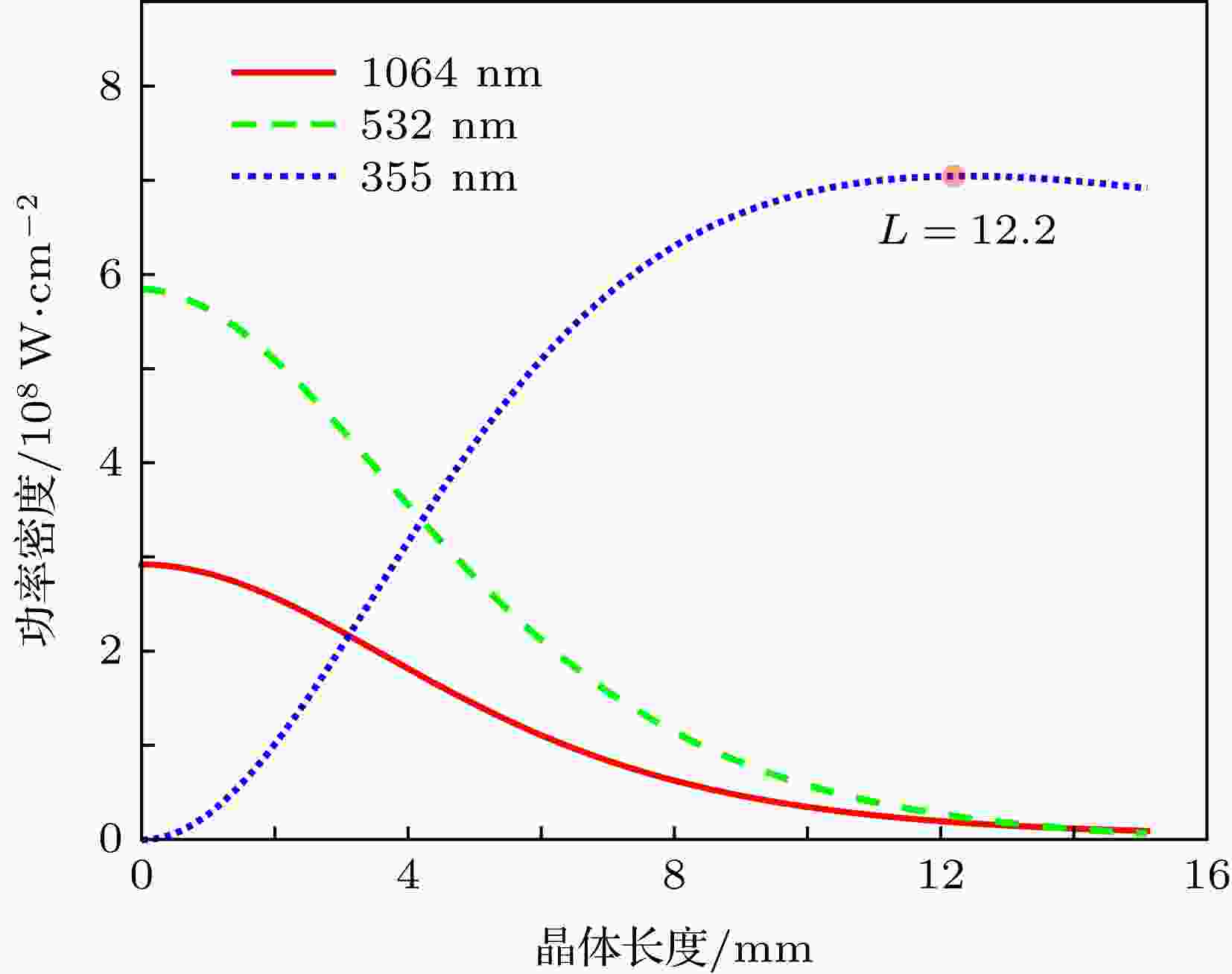 图 2 M = 1∶2时晶体中1064, 532和355 nm功率密度变化曲线
图 2 M = 1∶2时晶体中1064, 532和355 nm功率密度变化曲线Figure2. Power density curves of 1064, 532 and 355 nm laser in crystal with M = 1∶2.
为了解决和频晶体过长所带来的影响, 目前传统的方案是在1064 nm基频光倍频产生532 nm二次谐波的过程中主动限制转换效率到50%, 使入射到和频晶体的1064 nm基频光和532 nm倍频光的功率密度之比M = 1∶1. 此时, LBO和频晶体中的三个波长光束功率密度变化如图3所示. 由于限制了532 nm的入射功率, 改变了基频光和倍频光的光子数之比, 532 nm光子数量相对较少, 则其与1064 nm光子互相作用和频产生355 nm光子的概率增大, 使355 nm的功率密度在较短的晶体长度L = 8 mm时即可达到峰值. 此时, 1064 nm光子仍有剩余, 剩余1064 nm的光子会和355 nm光子作用从而发生回流, 使355 nm光子转换为1064和532 nm光子, 并且伴随着吸收损耗和相位失配的影响最终使三个波长的功率密度逐步振荡衰减.
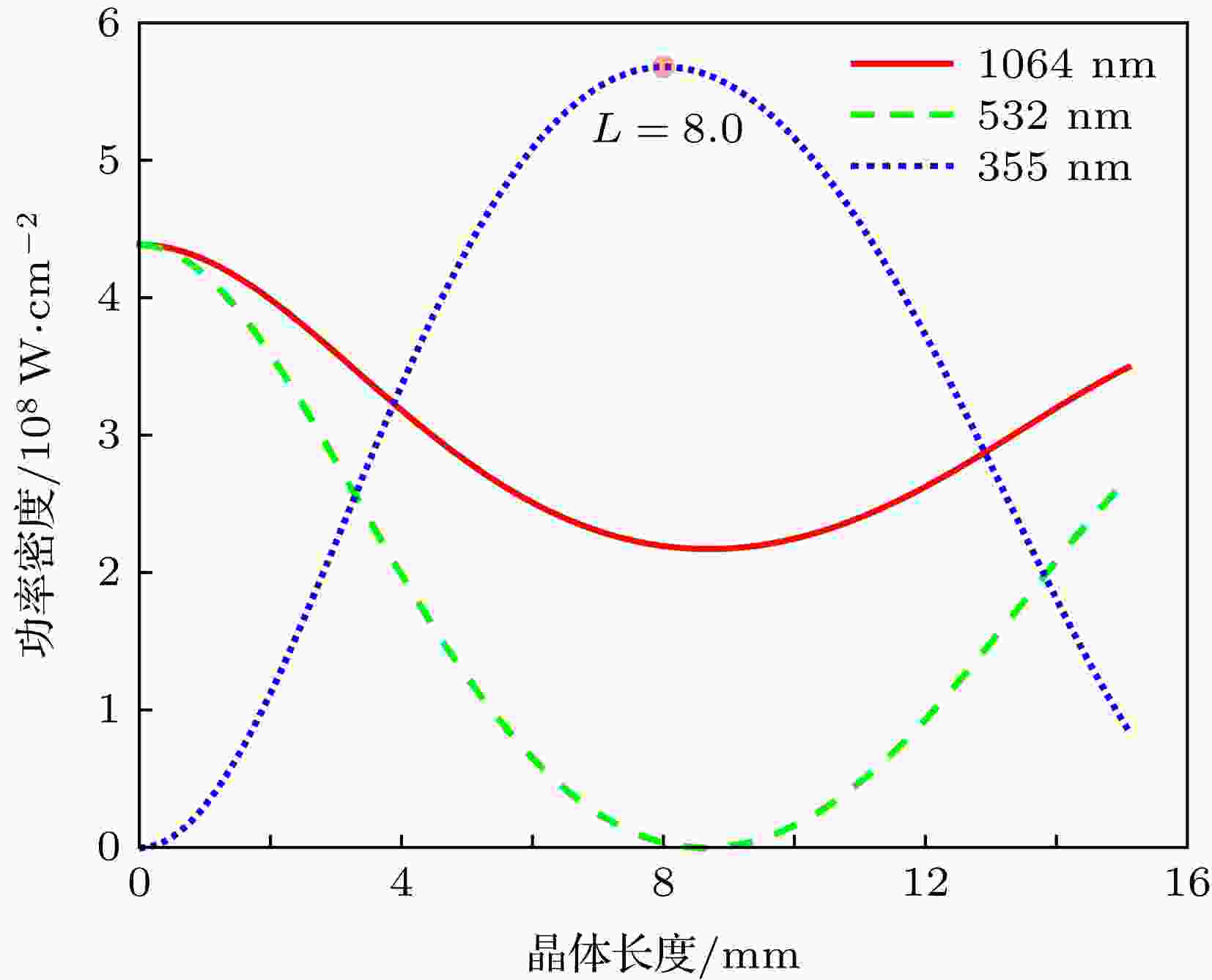 图 3 M = 1∶1时晶体中1064, 532, 和355 nm功率密度变化曲线
图 3 M = 1∶1时晶体中1064, 532, 和355 nm功率密度变化曲线Figure3. Power density curves of 1064, 532 and 355 nm laser in crystal with M = 1∶1.
传统方案在一定程度上解决了和频晶体过长带来的吸收和走离影响, 但由于其在倍频时限制了532 nm倍频光的转换效率, 使入射到和频晶体的532 nm倍频光功率降低, 导致最终355 nm紫外光的输出功率受到了限制. 传统方案产生的紫外355 nm输出功率如图4所示. 355 nm输出功率在L = 8 mm时达到峰值, 峰值功率约为19.4 W, 相对于入射532 nm光子数转换率约为78%.
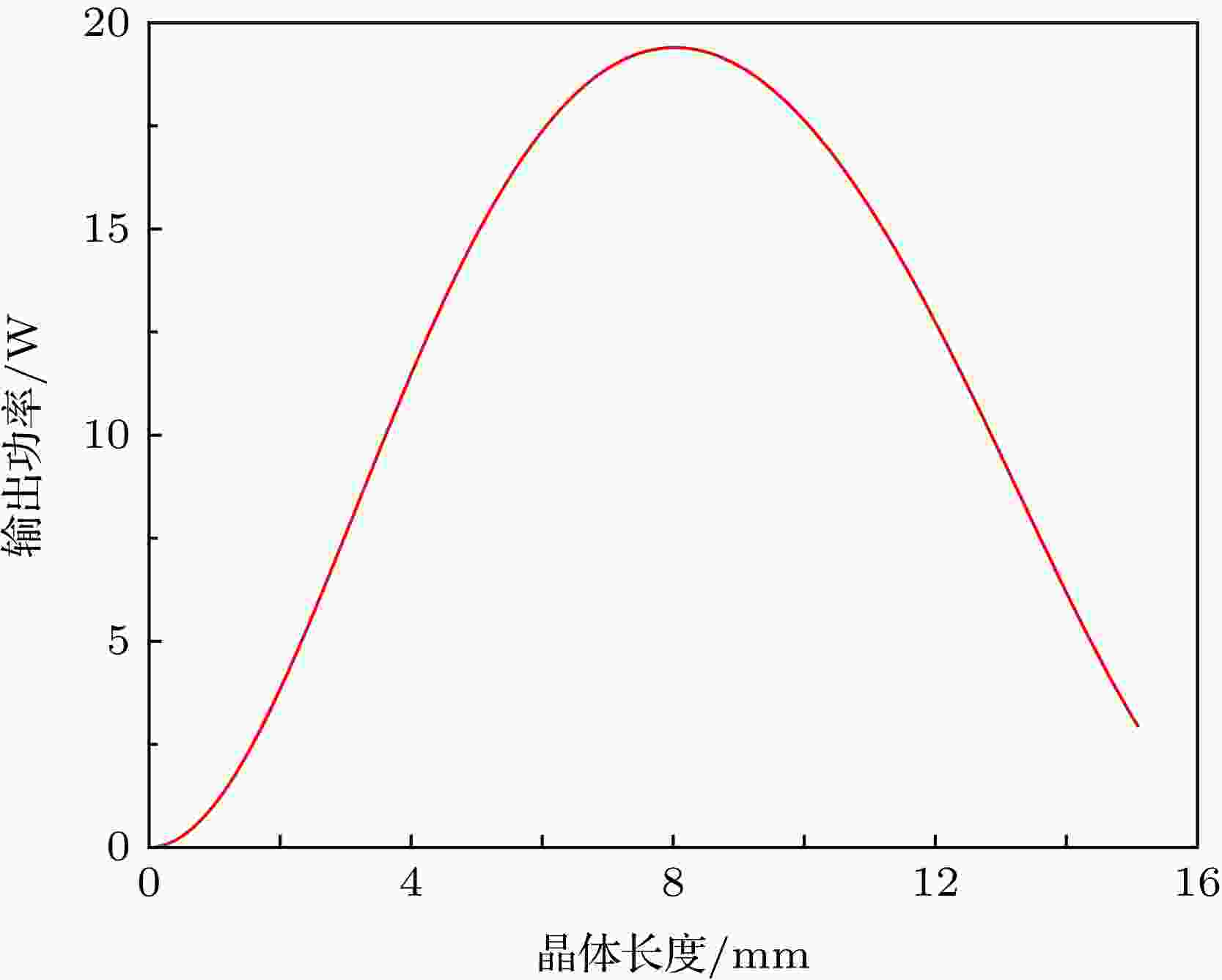 图 4 传统方案紫外355 nm输出功率与晶体长度关系曲线
图 4 传统方案紫外355 nm输出功率与晶体长度关系曲线Figure4. Relationship between UV 355 nm output power and crystal length under traditional scheme
不同于传统方案限制倍频效率来控制和频时的入射功率配比, 基频放大方案在倍频时可以保证532 nm的高转换效率, 倍频后对基频光1064 nm进行分离并放大, 调节入射到和频晶体的1064 nm基频光与532 nm倍频光的功率密度之比M. 通过基频放大技术可以进一步提高M值的大小, 由理想状态的M = 1∶2变大到2∶2, 3∶2, 甚至更高. 在1064和532 nm不同功率密度配比下, 355 nm和频光相对532 nm入射光子数的转换效率如图5所示. 当532 nm入射功率密度保持不变, 改变1064 nm入射功率密度, 随着功率密度之比M的增大, 峰值转换效率随之提高, 且达到355 nm和频转换效率峰值所需的LBO晶体长度变短. 不同M值条件下, 和频转换效率极值所对应的晶体长度如表1所示. 峰值转换效率主要由光子数相对较少的532 nm倍频光的功率密度以及和频晶体LBO对其的吸收决定, 达到峰值的LBO晶体长度则是由光子数相对较多的1064 nm基频光的功率密度决定. 该模拟结果与Ueda等[19]在进行紫外皮秒355 nm和频时不同入射条件下的实验数据相一致, 其增大了入射到和频晶体的功率密度之比M, 使入射光束的光子数之差增大, 和频转换效率提高. 所以, 为了获得更高转换效率的355 nm紫外光输出, 可以在前级倍频产生532 nm二次谐波时不考虑光子数配比, 只追求更高功率密度的532 nm倍频输出, 之后再将1064 nm基频光进行放大, 使最终和频产生355 nm时和频晶体可以在足够短的条件下把入射光高效转换, 避免晶体过长带来的吸收损耗和走离影响.
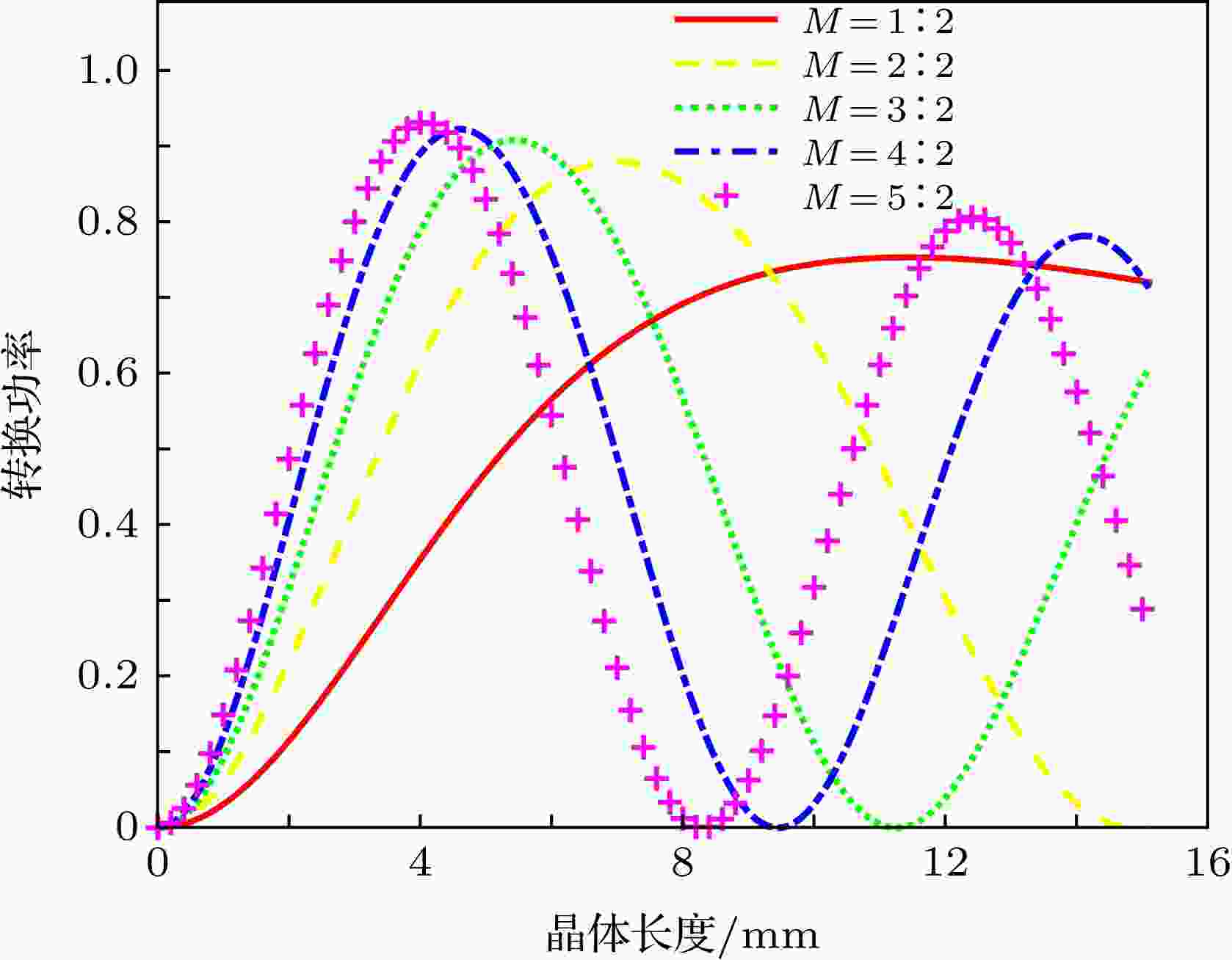 图 5 不同功率密度配比M对晶体长度和转换效率的影响
图 5 不同功率密度配比M对晶体长度和转换效率的影响Figure5. Effect of different power density ratios M on crystal length and conversion efficiency.
| M | 1∶2 | 2∶2 | 3∶2 | 4∶2 | 5∶2 |
| 晶体长度/mm | 12.2 | 7.0 | 5.4 | 4.6 | 4.1 |
表1不同功率密度配比M条件下峰值转换效率对应的晶体长度
Table1.Crystal lengths corresponding to the peak conversion as to different power density ratios M
基频放大方案在倍频时保证了532 nm倍频光的转换效率可达65%甚至更高, 采用基频光分离并放大的方式也使最后和频时1064 nm基频光和532 nm倍频光功率密度之比提高. 本文以65%倍频效率为参考, 入射到和频晶体的532 nm光功率约为21 W. 考虑到实际条件对基频放大的限制, 基频光由12 W放大到21 W, LBO和频晶体的入射光功率密度之比M采用1∶1的比例进行和频. 基频放大方案所产生的紫外皮秒355 nm输出效率如图6所示. 采用基频放大方案最终可以产生27.3 W左右355 nm紫外光, 相对532 nm倍频光子数的转换效率约为85.7%, 而传统方案仅能产生19.4 W左右355 nm紫外光, 转换效率约为78%. 相较于传统方案, 经过基频分离放大后, 紫外皮秒355 nm输出功率由原来的19.4 W提高到27.3 W, 提高40%以上, 同时使和频晶体最适长度缩短, 最适长度L由8 mm缩短到7 mm, 晶体吸收和走离影响减少, 光束质量更优.
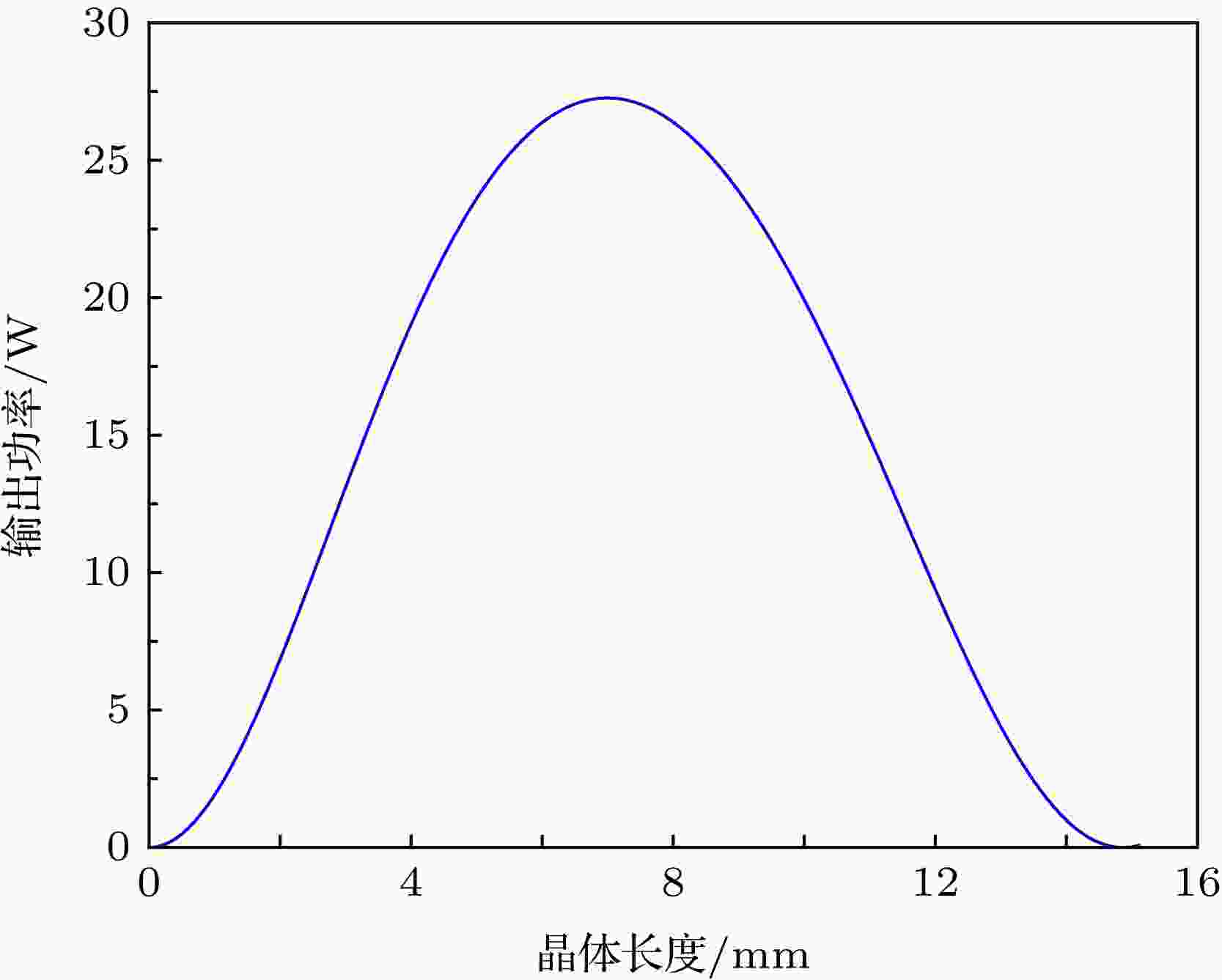 图 6 基频放大方案紫外355 nm输出功率与晶体长度关系曲线
图 6 基频放大方案紫外355 nm输出功率与晶体长度关系曲线Figure6. Relationship between UV 355 nm output power and crystal length based on fundamental frequency amplification
